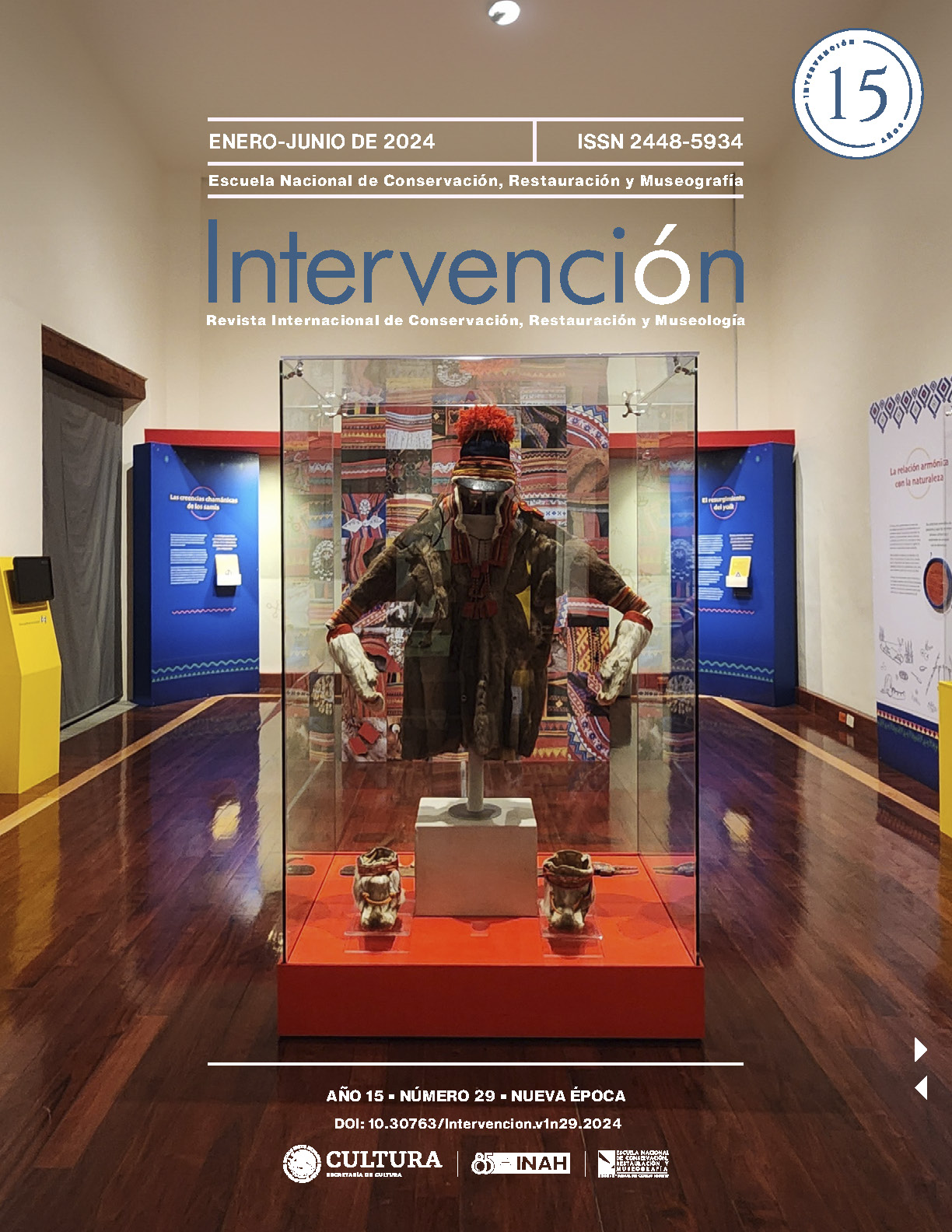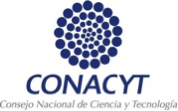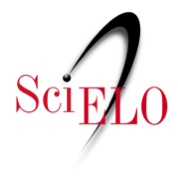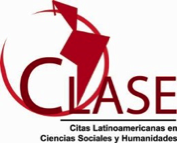Analyzing the Physicochemical Characteristics of an Archaeological Glass Collection from Mexico City, Mexico
DOI:
https://doi.org/10.30763/Intervencion.293.v1n29.72.2024Keywords:
Archaeometry, barrilla, tequesquite, glassmakers, vitrifyingAbstract
This paper is a preliminary study detailing the results of a chemical-physical analysis executed on 20 fragments of archaeological glass from Mexico City. The analysis was carried out using scanning electron microscopy (SEM) and X-ray microanalysis, two techniques not previously applied in Mexico for this purpose. Both the content of oxides and the sample’s physical characteristics allowed us to determine that approximately seventeen coincided with the types of components identified in European glass prior to the 18th century. The other three were identified as having come from a later period. The physical characteristics on the microscopic level were diverse and showed adhesions resulting from the effects of environmental degradation. This facilitates an analysis of oxide content and mechanisms of glass degradation that will allow us to further our understanding of this material’s production process in our country moving forward.
Downloads
References
Alvizar, R. M. J. (2007). Análisis de material vítreo proveniente de las excavaciones del Antiguo Palacio de Odontología de la UNAM (Tesis de Licenciatura). Escuela Nacional de Antropología e Historia.
Andrejevna, G. A. y Aldona, P. K. (1999). Biodeteriorative process on glass: Experimental proof of the role of fungi and cyanobacteria. Aereobiologia, 15, 181-191. https://doi.org/10.1023/A:1007616614172
Barrera, J. y Velde, B. (1989). A Study french medieval glass compos-ition. Journal glass studio, (31), 48-54. https://www.persee.fr/doc/arcme_0153-9337_1989_num_19_1_953
Bettembourg, J. M. (1976). Composition et altération des verres de vitraux anciens. Verres Réfract, 30(1), 36-42.
Cadena, A. C. (2018). Metodología para la caracterización de vidrios históricos aplicada a la colección de la ex hacienda del siglo XIX San Pedro Cholula (Tesis de Licenciatura). Universidad Nacional Autónoma de México. https://repositorio.unam.mx/contenidos/metodologia-para-la-caracterizacion-de-vidrios-historicos-aplicada-a-la-coleccion-de-la-ex-hacienda-del-siglo-xix-san-p-250247?c=EllZr7&d=false&q=*:*&i=6&v=1&t=-search_0&as=2
Cagno, S., Janssens K. y Mendera, M. (2008). Compositional analysis of Tuscan glass samples: in search of raw material fingerprint. Analytical and Bioanalytical Chemistry, 391, 1389-1395. https://link.springer.com/article/10.1007/s00216-008-1945-8
Cagno, S., Mendera, M., Jeffries, T. y Janssens, K. (2010). Raw materials for medieval to postmedieval Tuscan glassmaking: new insight from LA-ICP-MS analyses. Journal Archaeological Science, 37, 3030-3036. https://doi.org/10.1016/j.jas.2010.06.030
Cárdenas, K. C. (2020). Glass Production in Colonial México: Technology Transfer, Adoption and Adaptation (Tesis de Doctorado). University of California. https://escholarship.org/uc/item/9zw282c1
Carmona, N., García-Heras, M., Gil, C. y Villegas, Ma. (2005). Vidrios y grisallas del S. XV de la Cartuja de Miraflores (Burgos). Caracterización y estado de Conservación. Boletín de la Sociedad Española de Cerámica V., 44(4), 251-258.
Corning Museum of Glass. (30 de abril de 2023). Lithyalin glass. https://search.cmog.org/?keyword=hyalith%20red
Cox, G. A. y Ford, B. A. (1993). The longterm corrosion of glass by ground-water. Journal of Materials Science, 28, 5637-5647. https://doi. org/10.1007/BF00367840
Dungworth, D. (2012). Three and a half centuries of bottle manufacture. Industrial Archaeology Review, 34(1), 37-50. https://doi.org/10.1179/0309 072812Z.0000000002
Fernández, P. J. (2002). Algunas especies vegetales de uso industrial en la época romana. En Artiflex. Ingeniería romana en España (pp. 315-330). Ministerio de Educación Cultura y Deporte-Secretaría General Técnica-Museo Arqueológico Nacional.
Fernández, M. Á. (1990). El vidrio en México. Centro de Arte Vitro.
García, M., Gil, C., Carmona, N. y Villegas, Ma. (2003a). Efectos de la meteorización sobre los materiales de las vidrieras históricas. Materiales de Construcción, 53(270), 21-34. http://dx.doi.org/10.3989/mc.2003.v53. i270.271
García, M., Rincón J. Ma., Jimeno, M. A. y Villegas, Ma. (2003b). Estudio arqueométrico de cuentas de vidrio procedentes de la Necrópolis de Nu-mancia (S. II a. C.). Trabajos de Prehistoria, 60(1), 173-181. https://tp.revistas.csic.es/index.php/tp/article/view/129/130
Kreidl, N. J. y Weyl, W. A. (1941). Phosphates in ceramic ware: IV, Phosphate glasses. Journal of the American Ceramic Society, 24(11), 372-378.
Lima, A., Medici, T., Pires de Matos, A. y Verita, M. (2012). Chemical analysis of 17th century Millefiori glasses excavates in the Monastery of Sta. Clara-a-Velha, Portugal: comparison with Venetian and façon-de–Venise production. Journal Archaeological Science, 39, 1238-1248. https://doi.org/10.1016/j.jas.2012.01.006
Marrocchino, E., Telloli, C., Caraccio. S., Guarnieri, C. y Vaccaro, C. (2020). Medieval Glasworks in the City of Ferrara (North Eastern Italy): The Case Study of Piazza Municipale. Heritage, 3(3), 819-827. https://doi.org/10.3390/heritage3030045
Mirti, P., Davit, P. y Gulmini, M. (2002). Colourants and opacifiers in seventh and eighth century glass investigates by spectroscopic techniques. Analytical and Bionalytical Chemistry, 372, 221-239. https://doi.org/10.1007/s00216-001-1183-9
Müller, W., Torge, M. y Adam, K. (1994). Ratio of Ca/K2O as Evidence of Special Rhenish Type Medieval Stained Glass. Glastech Ber Glass Sci Technol, 67(2), 45-48.
Peralta, J. R. (2018). Materia prima, hornos y utillaje en la producción de vidrio de la Ciudad de México, s. XVIII. Estudios de Historia Novohispana, 58, 3-29. https://doi.org/10.22201/iih.24486922e.2018.58.63036
Peralta, J. R. (2011). El vidrio en la Ciudad de México. Productores y productos novohispanos, siglos XVI-XVIII. Editorial Académica Española.
Raedt, D., Janssens, K., Veeckman, J., Vincze, L., Vekemans, B. y Jeffries, T. E. (2002). Trace analysis for distinguishing beteween Venetian and façon-de-Venise glass vessels of the 16th and 17th century. Journal of Anaytical Atomic Spectrometry, 16, 1912-1917.
Rölleke, S., Gurtner, C., Drewello, U., Drewello, R., Lubitz, W. y Weissmann, R. (1999). Analysis of bacterial communities on historical glass by denaturing gradient gel electrophoresis of PCR–ampliefed gene fragments coding for 16S rRNA. Journal of Microbiological Methods, 36(1-2), 107-114. https://doi.org/10.1016/S0167-7012(99)00015-9
Schalm, O., Janssens, K., Wouters, H. y Caluwé D. (2007). Composition of 12th-18th Century Window Glass in Belgium: Non-Figurative Windows in Secular Buildings and Stained-Glass Windows in Religious Building. Spectrochimica Acta Part B: Atomic Spectroscopy, 62, 663-668.
Schalm, O., Caluwe, D., Wouters, H., Janssens, K., Verhaeghe, F. y Pieters, M. (2004). Chemical composition and deterioration of glass excavated in the 15th-16th century fishermen town of Raversijde (Belgium). Spectrochimica Acta Part B: Atomic Spectroscopy, 59(10-11), 1647-1656. https://doi. org/10.1016/j.sab.2004.07.012
Silvestri, A., Molin, G. y Salviulo, G. (2005). Archeological glass alteration products in marine and land-based environments: morphological, chemical and microtextural characterization. Journal of Non-Crystalline Solids, 351(16-17), 1338-1349. https://doi.org/10.1016/j.jnoncrysol.2005.03.013
Stanislas, A. (s. f.). L’opaline française au milieu du Ke siècle. Consultado el 30 de abril de 2023. http://institutions.ville-geneve.ch/fileadmin/user_ upload/ariana/documents/Expositions/Opaline_francaise_milieu_XIXe_ siecle_-_feuille_de_salle.pdf
Stockmann, G. J., Shirikova, L., Pokrovsky, S., Bénézet, P., Bovet, N., Gislason, S. R. y Oelkers, H. (2012). Does the presence of heterotrophic bacterium Pseudomonas reactans affect basaltic glass dissolution rates? Chemical Geology, 296-297, 1-18. https://doi.org/10.1016/j.chemgeo.2011.12.011
Tait, H. (2004). Five Thousand Years of Glass. University of Pennsylvania Press.
Tylor, E. B. (1861). Anáhuac or México and the Mexicans Ancient and Modern. Logman, Green.
Verita, M., Renier, A. y Zecchin, S. (2002). Chemical analyses of ancient glass finding excavated in the Venetian lagoon. Journal of Cultural Heritage, 3(4), 261-271.
Wolf, S., Cordula, K., Jürg, G., Trümpler, S. y Degryse, P. (7-11 de septiembre de 2015). The early medieval stained glass windows from St. John Müstair: materials, provenance and production technology. Annales du 20e Congrès de l’association internationale pour l’histoire du Verre, 660-667. AINV. ISBN: 978-3-86757-024-4.
Additional Files
Published
How to Cite
Issue
Section
License
Copyright (c) 2024 Instituto Nacional de Antropología e Historia (INAH)

This work is licensed under a Creative Commons Attribution-NonCommercial 4.0 International License.

Atribución-NoComercial 4.0 Internacional
https://creativecommons.org/licenses/by-nc/4.0/deed.es
Usted es libre de:
- Compartir — copiar y redistribuir el material en cualquier medio o formato
- Adaptar — remezclar, transformar y construir a partir del material
Bajo los siguientes términos:
-
Atribución — Usted debe dar crédito de manera adecuada, brindar un enlace a la licencia, e indicar si se han realizado cambios. Puede hacerlo en cualquier forma razonable, pero no de forma tal que sugiera que usted o su uso tienen el apoyo de la licenciante.
-
No Comercial — Usted no puede hacer uso del material con propósitos comerciales.




















